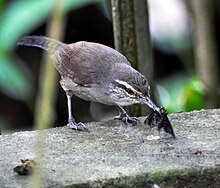Canebrake wren
Appearance
| Canebrake wren | |
|---|---|

| |
| Scientific classification | |
| Domain: | Eukaryota |
| Kingdom: | Animalia |
| Phylum: | Chordata |
| Class: | Aves |
| Order: | Passeriformes |
| Family: | Troglodytidae |
| Genus: | Cantorchilus |
| Species: | C. zeledoni
|
| Binomial name | |
| Cantorchilus zeledoni (Ridgway, 1878)
| |
The canebrake wren (Cantorchilus zeledoni) is a species of bird in the family Troglodytidae. It is found from eastern Nicaragua to northwestern Panama. Its natural habitats are subtropical or tropical dry forests, subtropical or tropical moist lowland forests, and heavily degraded former forest. It was considered conspecific with Cabanis's wren and the isthmian wren, together called the plain wren. It is considered as a distinct species because of different vocalizations and genetic divergence.
Description
The canebrake wren is a small, drab wren measuring 13 cm (5.1 in) in length.[2] It has a brown back, buffy flanks, white underparts and throat and wide white supercilium. The eye is red.
It has a loud 4-syllable song.
References
- ^ BirdLife International (2016). "Cantorchilus zeledoni". IUCN Red List of Threatened Species. 2016: e.T103889576A104217811. doi:10.2305/IUCN.UK.2016-3.RLTS.T103889576A104217811.en. Retrieved 13 January 2018.
- ^ Garrigues, Richard; Dean, Robert (2007). The Birds of Costa Rica. Ithaca: Zona Tropical/Comstock/Cornell University Press. p. 240. ISBN 978-0-8014-7373-9.
- Saucier, J.R., C. Sánchez, and M.D. Carling. 2015. Patterns of genetic and morphological divergence reveal a species complex in the Plain Wren (Cantorchilus modestus). Auk 132: 795–807.

